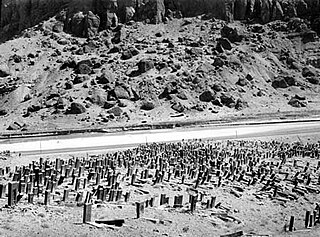
A khachkar, also known as a khatchkar or Armenian cross-stone is a carved, memorial stele bearing a cross, and often with additional motifs such as rosettes, interlaces, and botanical motifs. Khachkars are characteristic of medieval Christian Armenian art.

The Colorado State Capitol Building, located at 200 East Colfax Avenue in Denver, Colorado, United States, is the home of the Colorado General Assembly and the offices of the Governor of Colorado, Lieutenant Governor of Colorado, and the Colorado State Treasurer.

The Denver Civic Center is a civic center area that includes two parks surrounded by government and cultural buildings and spaces. Civic Center is located in central Denver, Colorado, on the south side of Downtown Denver. Much of the area is a historic district which was listed on the National Register of Historic Places in 1974. A somewhat smaller area was designated a U.S. National Historic Landmark in 2012 as one of the nation's finest examples of the City Beautiful movement of civic design. Denver Civic Center lies partially within the north end of an official Denver neighborhood also named Civic Center. It includes the Colorado State Capitol building, in the west end of Denver's official Capitol Hill neighborhood, and it includes a few buildings in the south end of Denver's Central Business District.

The Armenian Genocide Martyrs Monument, better known as Montebello Genocide Memorial, is a monument in Montebello, California in the Los Angeles metropolitan area, dedicated to the victims of the Armenian genocide of 1915. The monument, opened in April 1968, is a tower of eight arches supported on 75-foot-tall (23 m) white concrete columns. The memorial was designed by Hrant Agbabian. It is the oldest and largest memorial in the United States dedicated to the Armenian Genocide victims. The inscription on the memorial plaque reads:
Armenian Martyrs Memorial Monument: This Monument erected by Americans of Armenian descent, is dedicated to the 1,500,000 Armenian victims of the Genocide perpetrated by the Turkish Government, 1915–1921, and to men of all nations who have fallen victim to crimes against humanity.

The Armenian cemetery in Julfa was a cemetery near the town of Julfa, in the Nakhchivan exclave of Azerbaijan that originally housed around 10,000 funerary monuments. The tombstones consisted mainly of thousands of khachkars—uniquely decorated cross-stones characteristic of medieval Christian Armenian art. The cemetery was still standing in the late 1990s, when the government of Azerbaijan began a systematic campaign to destroy the monuments.

Shekher is a village in the Khojavend District of Azerbaijan, in the disputed region of Nagorno-Karabakh. The village had an ethnic Armenian-majority population prior to the 2020 Nagorno-Karabakh war, and also had an Armenian majority in 1989.
Hacısamlı is a village in the Lachin District of Azerbaijan.

Armenian Genocide Martyrs' Memorial in Deir ez-Zor, Syria, was a complex dedicated to victims of the Armenian genocide. The construction of the Martyrs' Memorial started in December 1989 and was completed in November 1990. It was consecrated on 4 May 1991 by Catholicos Karekin II of the Armenian Catholicosate of Cilicia. The memorial complex served as church, museum, monument, archive centre and exhibition. It was under the direct administration of the Armenian Prelacy, Diocese of Aleppo. Every year, on 24 April, tens of thousands of Armenian pilgrims from all over the world visited the Deir ez-Zor complex to commemorate the genocide victims, with the presence of their religious leaders.

The Armenian Genocide Monument in Nicosia, Cyprus, is a monument dedicated to the martyrs and the survivors of the Armenian genocide of 1915–1923. It is located within the Armenian complex on Armenia street in Acropolis, Strovolos, which contains the Armenian Prelature building, the Sourp Asdvadzadzin cathedral, the Nareg Armenian School, the marble khachkar, the bust of Archbishop Zareh Aznavorian and the statue of Gregory of Nareg.

Rafayel "Rafo" Israyelian was a Soviet Armenian architect.

The Armenian eternity sign or Arevakhach is an ancient Armenian national symbol and a symbol of the national identity of the Armenian people. It is one of the most common symbols in Armenian architecture, carved on khachkars and on walls of churches.
The Alfortville Armenian Genocide Memorial bombing was a hit-team headed attack undertaken by Grey Wolves member Abdullah Çatlı and paid for by the Turkish National Intelligence Organization. It occurred on 3 May 1984, in a heavily Armenian populated district of Alfortville, Val-de-Marne, Île-de-France.

Memorial and Museum of Martyred Turks Massacred by Armenians or Iğdır Genocide Memorial and Museum is a memorial-museum complex which promotes Armenian genocide denial. The construction for the memorial started on 1 August 1997 and it was dedicated on 5 October 1999 in Iğdır, Turkey. Its height is 43.5 metres (143 ft), making it the tallest monument in Turkey.

The Saint Thaddeus Church, is an Armenian Apostolic church in the town of Masis, Ararat Province, Armenia.

The Civil War Monument was a statue of a Civil War cavalryman by Jack Howland, installed outside the Colorado State Capitol in Denver. The memorial is also known as the Civil War Memorial, Soldier's Monument, and Civil War Soldier. The work was dedicated on July 24, 1909, after being cast by the Bureau Brothers.
The Colorado Tribute to Veterans Monument is a memorial commemorating World War I, World War II, Korea, Vietnam, and Persian Gulf War veterans, installed outside the Colorado State Capitol, in Denver. The monument was dedicated on November 10, 1990.

A 20-foot (6.1 m) bronze statue of decorated World War II soldier Joe P. Martínez is installed outside the Colorado State Capitol, in Denver.
The Republic of Artsakh and the United States do not have official diplomatic relations as the United States is among the vast majority of countries that does not recognize Artsakh as a sovereign nation and instead recognizes the region of Artsakh, or Nagorno-Karabakh, as part of Azerbaijan. Despite no formal relations, the Republic of Artsakh has a representative office in Washington, D.C. since November 1997.















